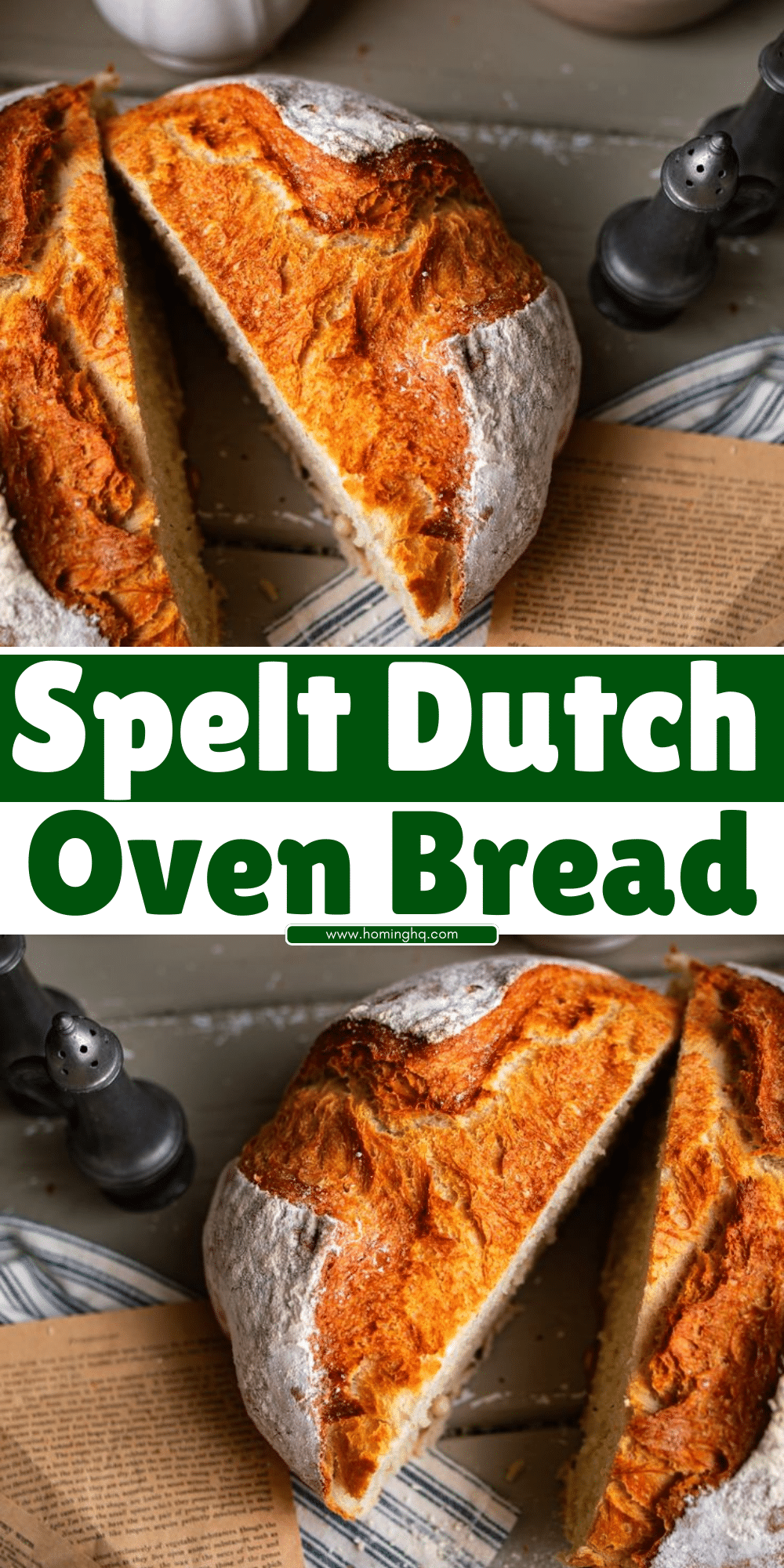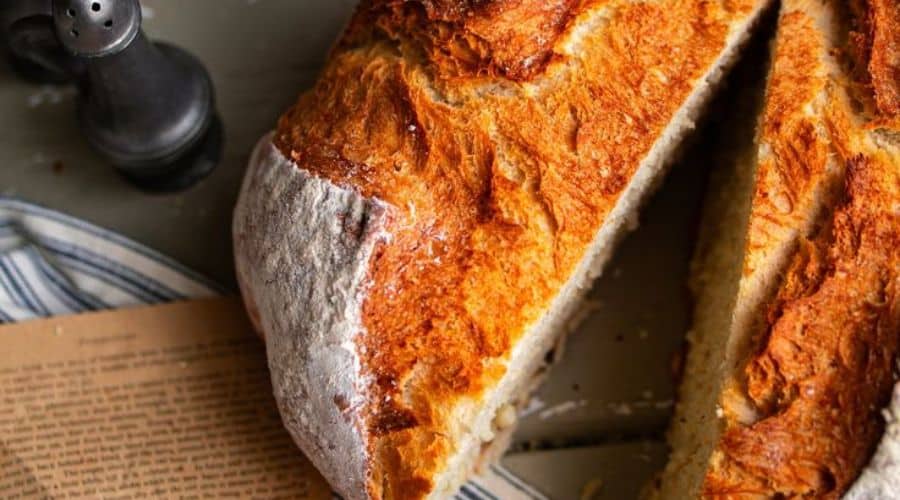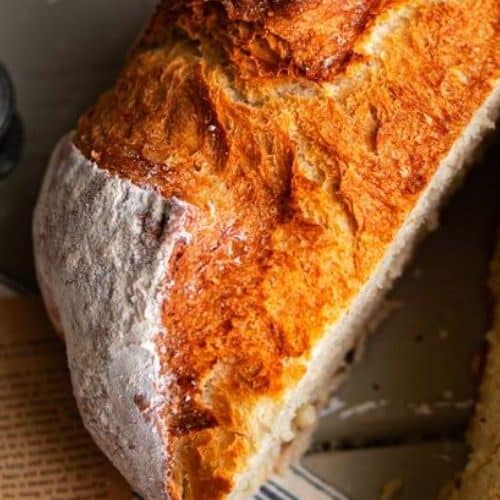All products are selected by our editorial team for quality. If you buy through our links, we may earn a small commission at no extra cost to you.
Spelt Dutch Oven Bread is a hearty, flavorful bread that combines the nutty taste of spelt flour with the traditional, rustic technique of baking in a Dutch oven.
This method ensures a crispy crust and a soft, airy interior that will impress both seasoned bakers and beginners alike.
Whether you’re a bread enthusiast or simply looking to explore new baking techniques, this recipe is a great way to create delicious homemade bread with minimal effort.
The beauty of Spelt Dutch Oven Bread lies in its simplicity.
With just a few ingredients and a bit of patience, you’ll be able to enjoy a warm, freshly baked loaf right from your own kitchen.
The Dutch oven traps heat and moisture, creating the ideal environment for the bread to rise and bake evenly, resulting in a perfect golden-brown crust.

Ingredients Needed for Spelt Dutch Oven Bread
To make Spelt Dutch Oven Bread, you’ll need a few essential ingredients that come together to create a delicious and flavorful loaf.
Here’s what you will need:
1. Spelt Flour
The star of this bread is spelt flour, which gives the bread a distinctive nutty flavor and a slightly lighter texture compared to traditional wheat flour.
Spelt flour is also a great alternative for those looking for a more digestible form of wheat.
2. Active Dry Yeast
Active dry yeast is the leavening agent that helps the dough rise and gives the bread its airy texture. It’s easy to work with and helps create the perfect crumb structure.
3. Warm Water
Warm water is used to activate the yeast and bring the dough together.
It’s important that the water is not too hot, as it can kill the yeast, but it should be warm enough to encourage fermentation.
4. Salt
Salt enhances the flavor of the bread and strengthens the dough’s structure.
It also helps to regulate yeast activity during the fermentation process.
5. Olive Oil
Olive oil adds richness and moisture to the dough, contributing to a soft crumb and a lovely, golden crust.
Step-by-Step Instructions for Making Spelt Dutch Oven Bread

Making Spelt Dutch Oven Bread is a simple and satisfying process. Follow these easy steps to create a beautiful loaf at home:
1. Activate the Yeast
Start by combining warm water and active dry yeast in a bowl. Let it sit for about 5-10 minutes, or until the mixture becomes frothy. This ensures the yeast is active and ready to help the dough rise.
2. Mix the Dough
In a large mixing bowl, combine spelt flour and salt.
Make a well in the center and pour in the yeast mixture and olive oil.
Stir with a wooden spoon or your hands until the dough begins to come together. It should be slightly sticky but manageable.
3. Knead the Dough
Turn the dough out onto a lightly floured surface. Knead it for about 8-10 minutes, adding a little more flour as needed, until it’s smooth and elastic.
Alternatively, you can use a stand mixer with a dough hook to knead the dough for about 5-6 minutes on medium speed.
4. First Rise
Place the dough in a lightly oiled bowl and cover it with a damp cloth or plastic wrap.
Let it rise in a warm place for 1-2 hours, or until it has doubled in size.
5. Shape the Dough
Once the dough has risen, punch it down gently to release the air.
Turn it out onto a floured surface and shape it into a round or oval loaf, depending on your preference.
6. Second Rise
Place the shaped dough onto a piece of parchment paper or a floured surface. Cover it and let it rise for another 30 minutes to an hour, until it has puffed up again.
7. Preheat the Dutch Oven
While the dough is doing its second rise, preheat your oven to 450°F (230°C).
Place your Dutch oven with its lid inside the oven to heat up for about 30 minutes.
This will help create the perfect environment for baking.
8. Bake the Bread
Carefully remove the preheated Dutch oven from the oven.
Using the parchment paper, transfer the risen dough into the Dutch oven.
Score the top of the dough with a sharp knife or bread lame to allow the bread to expand as it bakes.
Cover with the lid and return the Dutch oven to the oven.
Bake for 25 minutes with the lid on, then remove the lid and continue baking for another 15-20 minutes, or until the bread is golden brown and has a hollow sound when tapped on the bottom.
9. Cool the Bread
Once your bread is baked to perfection, remove it from the Dutch oven and let it cool on a wire rack for at least 30 minutes before slicing.
This allows the bread to finish cooking and ensures a better texture.
Tips and Tricks for Perfect Spelt Dutch Oven Bread
Baking the perfect Spelt Dutch Oven Bread can be achieved with a few helpful tips and tricks.
Here’s how to ensure your loaf turns out every time:
1. Use Room Temperature Water
When activating the yeast, make sure the water is warm but not too hot.
Ideal water temperature is between 100-110°F (37-43°C).
Too hot, and it may kill the yeast; too cold, and the yeast will take longer to activate.
2. Don’t Overwork the Dough
Spelt flour has a delicate gluten structure compared to wheat flour, so over-kneading can make the bread dense.
Knead just until the dough is smooth and elastic to avoid tough bread.
3. Allow for Enough Rise Time
Patience is key.
Ensure both rises are allowed enough time for the dough to double in size.
If the dough isn’t rising as expected, try placing it in a slightly warmer area, like near a heater or in an oven with just the light on.
4. Preheat the Dutch Oven
Make sure your Dutch oven is thoroughly preheated before placing the dough inside.
This helps achieve a crispy crust and an even bake.
5. Scoring the Bread
Scoring the dough before baking helps the bread expand evenly.
Use a sharp knife or bread lame to create a few shallow cuts in the top.
This not only helps with the rise but also gives the loaf a beautiful artisan look.
6. Experiment with Flavor Additions
Feel free to customize your Spelt Dutch Oven Bread with extra flavorings.
You can add herbs, seeds, or even dried fruits for a unique twist on the classic recipe.
Health Benefits of Spelt Flour
Spelt flour isn’t just delicious—it’s also packed with health benefits that make it a great alternative to traditional wheat flour.
Here’s why you should consider incorporating spelt into your diet:
1. Higher Nutritional Value
Spelt flour contains a rich array of vitamins and minerals, including B vitamins, iron, magnesium, phosphorus, and zinc.
These nutrients are important for energy production, bone health, and immune function.
2. Easier to Digest
Spelt flour contains a different form of gluten compared to modern wheat, which is easier for some people to digest.
Although it still contains gluten, it may be a gentler option for individuals who are sensitive to wheat but not gluten-intolerant.
3. Rich in Fiber
Spelt flour is a good source of dietary fiber, which aids in digestion and helps regulate blood sugar levels.
Consuming fiber-rich foods like spelt can also promote feelings of fullness, which is beneficial for weight management.
4. Supports Heart Health
The fiber, antioxidants, and essential fatty acids found in spelt flour help support cardiovascular health by lowering cholesterol levels and improving blood circulation.
5. Good Source of Protein
Spelt flour contains more protein than regular wheat, which is essential for muscle repair, immune function, and overall body repair.
This makes it a great option for those looking to boost their protein intake.
Frequently Asked Questions
Here are some commonly asked questions about Spelt Dutch Oven Bread and spelt flour:
1. Can I use regular flour instead of spelt flour?
Yes, you can substitute regular all-purpose flour for spelt flour, but the texture and flavor will change slightly.
Spelt flour has a nuttier taste and a lighter, more delicate texture.
2. Is spelt flour gluten-free?
No, spelt flour contains gluten.
However, it has a different gluten structure that some people find easier to digest compared to regular wheat flour.
It is not suitable for those with celiac disease or a severe gluten allergy.
3. Can I make this recipe with whole spelt flour?
Absolutely!
You can use whole spelt flour for a denser, more earthy loaf.
Just keep in mind that you may need to adjust the hydration levels, as whole spelt flour absorbs more water.
4. Can I make Spelt Dutch Oven Bread without a Dutch oven?
Yes, if you don’t have a Dutch oven, you can bake the bread on a baking stone or a sheet pan.
Just place a shallow pan of water at the bottom of the oven to create steam, which will help form the crispy crust.
5. How long does Spelt Dutch Oven Bread stay fresh?
Spelt Dutch Oven Bread is best enjoyed fresh, but it will stay fresh for about 2-3 days when stored in an airtight container or wrapped in a cloth.
For longer storage, you can freeze it and reheat it when needed.
Conclusion
Spelt Dutch Oven Bread is a wonderful way to embrace the wholesome goodness of spelt flour in your baking.
The process may take some time, but the results are well worth it—crispy on the outside, soft and airy on the inside.
With its nutty flavor and health benefits, this bread is an excellent addition to your baking repertoire.
By following the simple steps outlined above and utilizing a few helpful tips, you can easily create a delicious loaf of spelt bread at home.
Whether you’re new to baking or a seasoned pro, this recipe will not disappoint. Happy baking!

Spelt Dutch Oven Bread
Equipment
- 1 Dutch Oven (4-6 quart)
- 1 Mixing Bowl (Large)
- 1 Wooden spoon or spatula
- 1 Baking parchment paper (optional, for easy transfer)
- 1 Kitchen towel or plastic wrap (for covering dough)
- 1 Knife or bread lame (for scoring the dough)
Ingredients
- 3 ½ cups 420g spelt flour
- 1 ½ teaspoons 9g active dry yeast
- 1 ¼ cups 300ml warm water
- 1 teaspoon 6g salt
- 1 tablespoon 15ml olive oil
Instructions
- Activate the Yeast: In a small bowl, mix warm water and active dry yeast. Let it sit for 5-10 minutes until frothy.
- Mix the Dough: In a large bowl, combine spelt flour and salt.Create a well in the center and pour in the yeast mixture and olive oil. Stir until a dough begins to form.
- Knead the Dough: Turn the dough out onto a floured surface and knead for 8-10 minutes until smooth and elastic. Alternatively, use a stand mixer with a dough hook.
- First Rise: Place the dough in a lightly oiled bowl, cover with a damp cloth, and let it rise for 1-2 hours, or until it doubles in size.
- Shape the Dough: Punch down the dough, turn it out onto a floured surface, and shape it into a round or oval loaf.
- Second Rise: Place the dough on parchment paper or a floured surface. Cover and let it rise for another 30 minutes to 1 hour.
- Preheat the Dutch Oven: Preheat the oven to 450°F (230°C). Place the Dutch oven inside the oven to heat for about 30 minutes.
- Bake the Bread: Transfer the dough (using parchment paper) into the preheated Dutch oven. Score the top with a sharp knife. Bake for 25 minutes with the lid on, then remove the lid and bake for an additional 15-20 minutes, or until golden brown and hollow-sounding when tapped.
- Cool the Bread: Remove the bread from the Dutch oven and let it cool on a wire rack for at least 30 minutes before slicing.
Notes
- Flour Variations: You can experiment with adding a small amount of whole spelt flour for a denser loaf, but you may need to adjust the water slightly.
- No Dutch Oven? If you don’t have a Dutch oven, you can bake this bread on a baking stone or sheet pan. Just place a pan of water in the oven to help create steam for a crispy crust.
- Rise Time: The rise times can vary depending on the room temperature. If your kitchen is cold, you can place the dough in an oven with just the light on to help it rise more effectively.
- Storage: This bread is best eaten fresh but can be stored for 2-3 days in an airtight container. It also freezes well if you want to save some for later.

